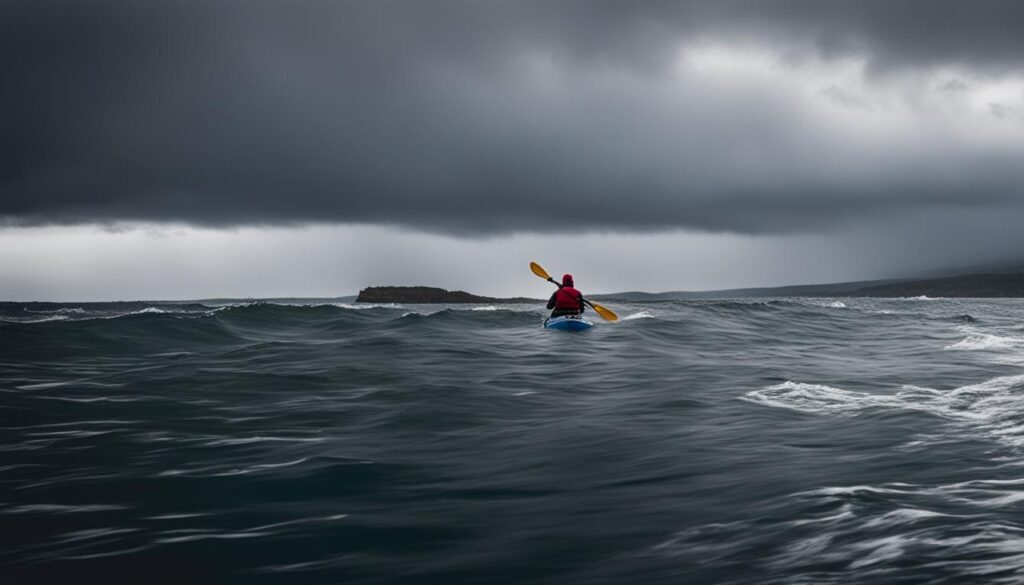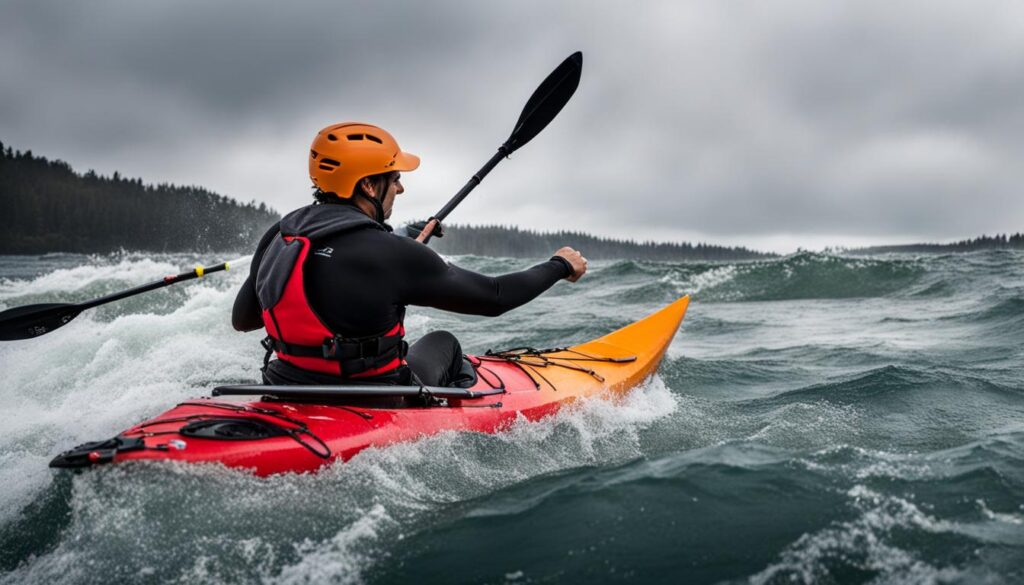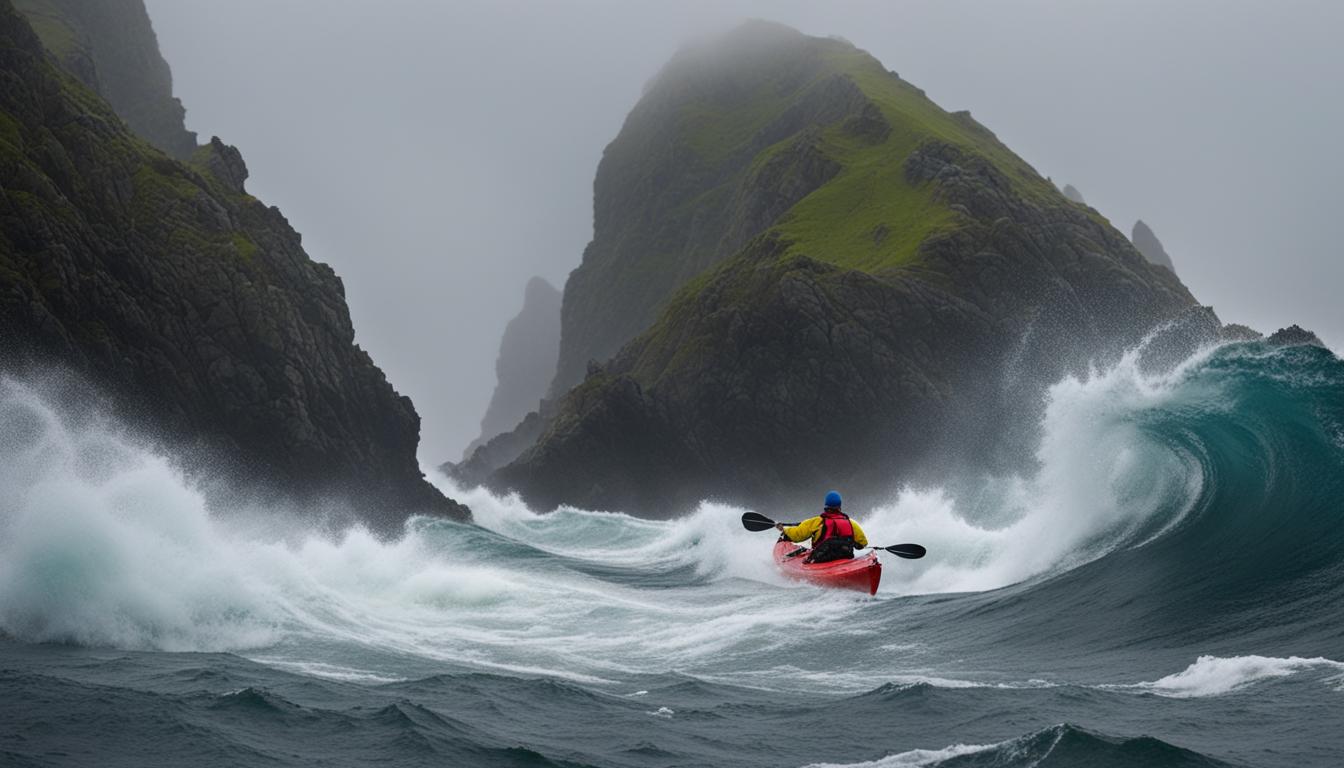When planning a sea kayaking adventure, it is crucial to understand and take into account the weather patterns to ensure a safe and enjoyable experience. Monitoring temperature, wind speed, wind direction, and incoming storms is essential for kayakers. Water temperature is also an important factor to consider, as hypothermia can still occur even during the summer months.
During June, water temperatures are typically in the 40s-50s, while in July and August they increase to the 60s. Wind speed and direction are significant indicators of safe kayaking conditions, with winds under 10 knots (about 11.5 mph) being ideal. It is important to be aware of wind gusts and their impact on water choppiness. For safe kayaking, it is recommended to avoid going out on the water when winds reach 15 knots or more. Wearing a personal flotation device (PFD) is a non-negotiable safety measure for all paddlers. By taking these weather-related factors into consideration, kayakers can better prepare for and adapt to different weather conditions for a safer and more enjoyable experience.
Key Takeaways:
- Understanding weather patterns is crucial for safe sea kayaking
- Monitoring temperature, wind speed, wind direction, and incoming storms is essential
- Water temperature can affect the risk of hypothermia
- Winds under 10 knots are ideal for safe kayaking
- Wearing a personal flotation device (PFD) is a non-negotiable safety measure
Importance of Wind Direction and Speed in Kayaking
When it comes to kayaking, understanding and adapting to different weather conditions is essential for a safe and enjoyable experience. One important factor to consider is wind direction and speed, as they can greatly impact the smoothness and ease of your paddling journey.
Wind direction plays a crucial role in determining the level of difficulty and effort required while kayaking. Paddling against the wind can be exhausting and make your journey more challenging. It is important to check the wind forecast before heading out and choose a paddling location that aligns with the wind direction. Starting your paddle with the wind at your back can conserve energy and make the journey more enjoyable.
Additionally, monitoring wind speed is equally important. Ideally, winds under five miles per hour provide a stress-free kayaking experience. Planning your kayaking route based on wind direction and speed can help you avoid unnecessary challenges and enjoy a more relaxed trip.
By adapting to weather changes and staying aware of wind direction and speed, kayakers can prepare themselves for different conditions and make informed decisions. Utilizing weather forecasts and being mindful of wind patterns not only enhances safety but also contributes to a more enjoyable kayaking experience.

Table: Ideal Wind Conditions for Kayaking
| Wind Speed | Wind Conditions |
|---|---|
| Less than 5 mph | Ideal for a stress-free kayaking experience |
| 5-10 mph | Still manageable, but be prepared for some resistance |
| 10-15 mph | Kayaking becomes more challenging, especially against the wind |
| Above 15 mph | Avoid kayaking as it can be unsafe and extremely difficult |
Kayaking in Extreme Weather: Understanding the Impact of Water Temperature
When embarking on a sea kayaking adventure, being prepared for various weather conditions is vital for your safety and enjoyment. One significant factor to consider is water temperature. Even during the summer months, the water in lakes and bays may take a while to warm up, putting you at risk of hypothermia. Understanding the impact of water temperature and taking appropriate precautions are essential for a safer kayaking experience.
Early in the summer, water temperatures can range from the 40s to 50s, posing a significant risk of hypothermia. Cold shock and the rapid drop in body temperature can have dangerous consequences. As the summer progresses, water temperatures typically rise to the more manageable 60s, reducing the risk of hypothermia but still requiring caution.
It is crucial to be mindful of the potential dangers of cold water and dress appropriately for the conditions. Wearing a wetsuit or drysuit can help insulate your body from the cold water. Additionally, always check current water temperatures before heading out and adjust your clothing choices accordingly. Being aware of the impact of water temperature and taking the necessary precautions will ensure a safer and more enjoyable kayaking experience.
Table: Water Temperature and Seasonal Variations
| Month | Water Temperature Range (°F) |
|---|---|
| June | 40s-50s |
| July | 60s |
| August | 60s |
Staying informed about water temperature changes and taking appropriate measures to dress for the conditions will ensure your safety while kayaking. By understanding the impact of water temperature and being prepared, you can confidently navigate extreme weather conditions and enjoy your kayaking adventures to the fullest.
“Being aware of the impact of water temperature and taking the necessary precautions will ensure a safer and more enjoyable kayaking experience.”
Safety Measures and Equipment for Kayaking
Ensuring safety while kayaking involves not only monitoring weather patterns but also implementing proper safety measures and having the right equipment. One non-negotiable safety measure is wearing a personal flotation device (PFD) at all times. Coast Guard-approved PFDs should be worn snugly and not too tight, providing the necessary buoyancy in case of an emergency.
It is also crucial for kayakers to familiarize themselves with their equipment and know how to use it effectively. Learning how to use a bilge pump and paddle float for various recoveries can be essential in case the kayak capsizes. These tools are designed to help you quickly remove water from the kayak and re-enter it safely.
Carrying essential safety gear is another important aspect of preparation. A whistle can be used to signal for help, waterproof matches can come in handy if you need to start a fire in an emergency situation, and a first aid kit is essential for treating minor injuries. Additionally, packing spare clothing can help you stay dry and warm if you get wet during your kayaking adventure. Being prepared with the right equipment and safety gear ensures that you are ready to handle any unexpected situations that may arise.
Kayaking Safety Checklist
- Wear a Coast Guard-approved personal flotation device (PFD) at all times.
- Familiarize yourself with your equipment, including bilge pumps and paddle floats.
- Carry essential safety gear, such as a whistle, waterproof matches, a first aid kit, and spare clothing.
- Check weather conditions and plan your kayaking trips around favorable weather.
- Inform someone of your kayaking plans, including your intended route and expected return time.
- Stay hydrated and bring enough water and snacks for your trip.
- Follow proper kayaking techniques and paddle with a buddy whenever possible.
- Stay aware of your surroundings and be prepared for unexpected changes in weather or water conditions.

| Essential Safety Gear | Usage |
|---|---|
| Personal Flotation Device (PFD) | Provides buoyancy and keeps you afloat in case of an emergency. |
| Bilge Pump | Used to remove water from the kayak in case it capsizes or takes on water. |
| Paddle Float | Assists in re-entering the kayak after capsizing by stabilizing the kayak. |
| Whistle | Used to signal for help or attract attention in emergency situations. |
| Waterproof Matches | Allows you to start a fire for warmth and cooking in case of an emergency. |
| First Aid Kit | Contains essential medical supplies for treating minor injuries. |
| Spare Clothing | Keeps you dry and warm in case you get wet during your kayaking trip. |
Conclusion
Understanding and preparing for weather patterns is essential for safe and enjoyable sea kayaking experiences. By monitoring temperature, wind speed, wind direction, and water conditions, you can make informed decisions about when and where to paddle. Adapting to weather changes and being aware of potential risks, such as hypothermia, allows you to plan your trips accordingly and prioritize safety.
Wearing appropriate safety gear, familiarizing yourself with equipment, and following recommended safety measures further enhance the overall safety of your kayaking adventures. By incorporating weather-related factors into your trip planning, you can confidently navigate various climates and enjoy your time on the water.
Remember to always stay informed about kayaking weather patterns and prepare accordingly. Whether you’re kayaking in extreme weather or planning a trip in more favorable conditions, being aware of the weather forecast and taking necessary precautions will contribute to a safer and more enjoyable experience. So, get out there, explore different kayaking destinations, and make the most of your sea kayaking adventures!
FAQ
What weather factors should I consider when planning a sea kayaking adventure?
When planning a sea kayaking adventure, it is crucial to monitor temperature, wind speed, wind direction, and incoming storms. Additionally, water temperature is important to consider to prevent hypothermia.
What are the typical water temperature ranges during the summer months?
In June, water temperatures are typically in the 40s-50s. In July and August, they increase to the 60s.
What wind speed is ideal for safe kayaking?
Winds under 10 knots (about 11.5 mph) are ideal for safe kayaking conditions. It is recommended to avoid going out on the water when winds reach 15 knots or more.
Why is wearing a personal flotation device (PFD) important?
Wearing a PFD is a non-negotiable safety measure for all paddlers. It ensures your safety in case of emergencies or accidents.
How should I plan my kayaking route based on wind direction?
It is important to check the wind forecast and choose paddling locations that are ideal for different wind directions. Starting your paddle with the wind at your back can help conserve energy.
How can water temperature affect my kayaking experience?
Water temperature is a critical factor to consider. Hypothermia is a risk, especially in the early summer when water temperatures range from the 40s to 50s. Understanding the impact of water temperature on the body is important for safety.
What safety measures should I take while kayaking?
Wearing a PFD at all times is essential. Additionally, familiarize yourself with your equipment, carry essential safety gear, and plan your kayaking trips around favorable weather conditions.





